

Bulletin board system. History[edit] Precursors[edit] A precursor to the public bulletin board system was Community Memory, started in August 1973 in Berkeley, California.
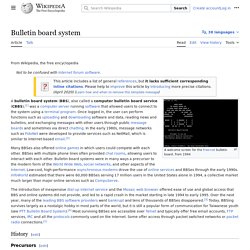
Useful microcomputers did not exist at that time, and modems were both expensive and slow. Community Memory therefore ran on a mainframe computer and was accessed through terminals located in several San Francisco Bay Area neighborhoods.[3] The poor quality of the original modem connecting the terminals to the mainframe prompted a user to invent the Pennywhistle modem, whose design was highly influential in the mid-1970s. Iodine. Chemical element with atomic number 53 Chemical element with atomic number 53 Iodine occurs in many oxidation states, including iodide (I−), iodate (IO−3), and the various periodate anions.
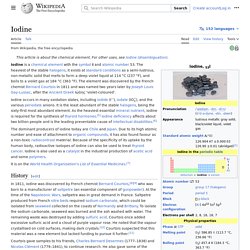
It is the least abundant of the stable halogens, being the sixty-first most abundant element. It is the heaviest essential mineral nutrient. Thirty Seconds to Mars. Thirty Seconds to Mars (commonly stylized as 30 Seconds to Mars) is an American rock band from Los Angeles, California, formed in 1998.
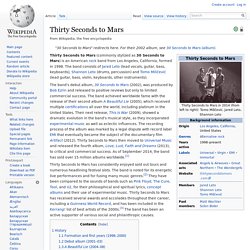
The band consists of Jared Leto (lead vocals, guitar, bass, keyboards), Shannon Leto (drums, percussion) and Tomo Miličević (lead guitar, bass, violin, keyboards, other instruments). History Formation and first years (1998–2000) Thirty Seconds to Mars started in 1998 in Los Angeles, California, as a collaboration between brothers Jared Leto and Shannon Leto, who had been playing music together since their childhood.[4] The duo later expanded to a four piece when they added guitarist Solon Bixler and bassist Matt Wachter to the line-up.
Additional guitarist Kevin Drake, who first auditioned for the position of bassist, also joined the band as a touring musician. Classical conditioning. Overview[edit] Classical conditioning was first studied in detail by Ivan Pavlov through experiments with dogs and published in 1897.
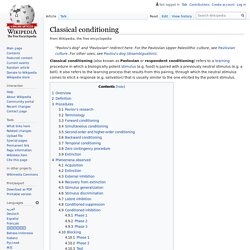
It began when the Russian physiologist observed - while he was studying digestion - that the dogs serving as his subjects drooled when they were being served meat.[1] Together with operant conditioning, classical conditioning became the foundation of behaviorism, a school of psychology which was dominant in the mid-20th century and is still an important influence on the practice of psychological therapy and the study of animal behavior. Classical conditioning is a basic learning process, and its neural substrates are now beginning to be understood. Though it is sometimes hard to distinguish classical conditioning from other forms of associative learning (e.g. instrumental learning and human associative memory), a number of observations differentiate them, especially the contingencies whereby learning occurs.[2] Declarative programming.
Common declarative languages include those of database query languages (e.g., SQL, XQuery), regular expressions, logic programming, functional programming, and configuration management systems.
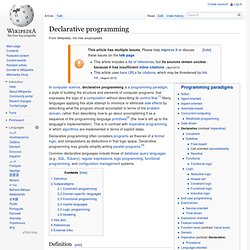
Definition[edit] Control flow. Within an imperative programming language, a control flow statement is a statement the execution of which results in a choice being made as to which of two or more paths to follow.
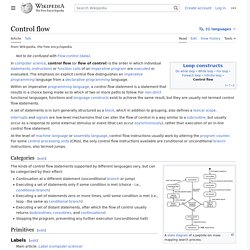
For non-strict functional languages, functions and language constructs exist to achieve the same result, but they are usually not termed control flow statements. Categories[edit] The kinds of control flow statements supported by different languages vary, but can be categorized by their effect: Primitives[edit] Labels[edit] Software flow control. Representation[edit] The ASCII standard does not reserve any control characters for use as XON/XOFF specifically.
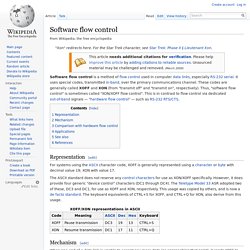
However, it does provide four generic "device control" characters (DC1 through DC4). The Teletype Model 33 ASR adopted two of these, DC3 and DC1, for use as XOFF and XON, respectively. Fibonacci number. A tiling with squares whose side lengths are successive Fibonacci numbers In mathematics, the Fibonacci numbers are the numbers in the following integer sequence, called the Fibonacci sequence, and characterized by the fact that every number after the first two is the sum of the two preceding ones: Often, especially in modern usage, the sequence is extended by one more initial term:

Dd (Unix) Usage varies across different operating systems.
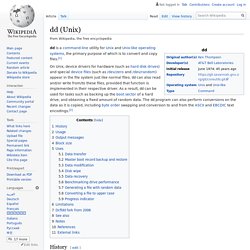
Also, certain features of dd will depend on the computer system capabilities, such as dd's ability to implement an option for direct memory access. Atom (text editor) Desktop publishing. Desktop publishing (abbreviated DTP) is the creation of documents using page layout skills on a personal computer.
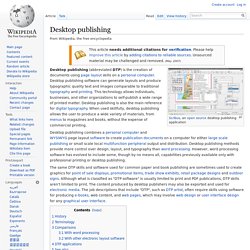
Desktop publishing software can generate layouts and produce typographic quality text and images comparable to traditional typography and printing. This technology allows individuals, businesses, and other organizations to self-publish a wide range of printed matter. Desktop publishing is also the main reference for digital typography. When used skillfully, desktop publishing allows the user to produce a wide variety of materials, from menus to magazines and books, without the expense of commercial printing.
Desktop publishing combines a personal computer and WYSIWYG page layout software to create publication documents on a computer for either large scale publishing or small scale local multifunction peripheral output and distribution. Agile software development. Agile software development is a set of principles for software development in which requirements and solutions evolve through collaboration between self-organizing,[1] cross-functional teams. It promotes adaptive planning, evolutionary development, early delivery, and continuous improvement, and it encourages rapid and flexible response to change.[2] Agile itself has never defined any specific methods to achieve this, but many have grown up as a result and have been recognized as being 'Agile'.
The Manifesto for Agile Software Development,[3] also known as the Agile Manifesto, was first proclaimed in 2001, after "agile methodology" was originally introduced in the late 1980s and early 1990s. The manifesto came out of the DSDM Consortium in 1994, although its roots go back to the mid 1980s at DuPont and texts by James Martin[4] and James Kerr et al.[5] History[edit] Incremental software development methods trace back to 1957.[6] In 1974, E. The Agile Manifesto[edit] Ethereum. Ethereum is a blockchain-based virtual machine and Web 3.0 platform featuring stateful user-created digital contracts and a Turing-complete contract programming language. Ethereum uses its underlying network unit, Ether, as payment to execute Ethereum contracts as a workaround to the halting problem.
Dynamic Kernel Module Support. Dynamic Kernel Module Support (DKMS) is a program/framework that enables generating Linux kernel modules whose sources generally reside outside the kernel source tree. The concept is to have DKMS modules automatically rebuilt when a new kernel is installed. An essential feature of DKMS is that it automatically recompiles all DKMS modules if a new kernel version is installed. This allows drivers and devices outside of the mainline kernel to continue working after a Linux kernel upgrade. List of Java virtual machines. This article provides non-exhaustive lists of Java SE Java virtual machines (JVMs). It does not include a large number of Java ME vendors. Note that Java EE runs on the standard Java SE JVM but that some vendors specialize in providing a modified JVM optimized for Java EE applications.
A large amount of Java development work takes place on Windows, Solaris, Linux and FreeBSD, primarily with the Sun JVMs. Note the further complication of different 32-bit/64-bit varieties. The primary reference Java VM implementation is HotSpot, produced by Oracle Corporation. ZeroVM. Sandboxing[edit] Boolean algebra. Arkanoid. Overview[edit] Wmctrl. Operations[edit] Knights and Knaves. Labyrinth. In Greek mythology, the Labyrinth (Greek λαβύρινθος labyrinthos,[1]) was an elaborate structure designed and built by the legendary artificer Daedalus for King Minos of Crete at Knossos.
FrontPage - JythonWiki. The purpose of a programming language is to let software developers express their intentions as simply and directly as possible. - JimHugunin Jython is a Java implementation of Python that combines expressive power with clarity. GLX. The Linux DRI Graphic Stack in 2013 History[edit] Klik (packaging method) Klik was a system for software download and usage on GNU/Linux. Hybris (software) UC Browser.
PU learning. Nashorn (JavaScript engine) Database. SpiderMonkey (JavaScript engine) Message Passing Interface. Computer cluster. Zfone. Unified Expression Language. Asm.js. Waffle (disambiguation) Blackbird (online platform) Netscape. Internet OS. Component Object Model. Switch statement. NPAPI. Comparison of application servers. Middleware. Natural language processing. HTML5 in mobile devices. Strategic business unit. Top-down and bottom-up design.